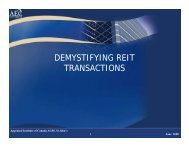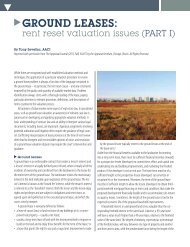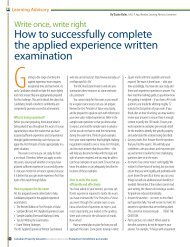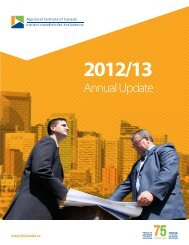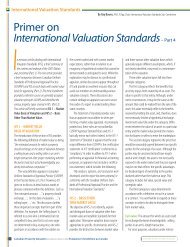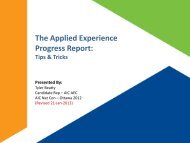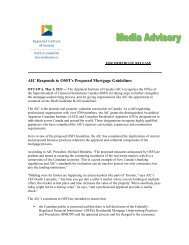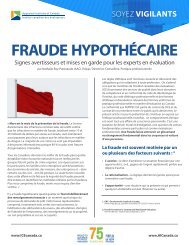Book 2 - Appraisal Institute of Canada
Book 2 - Appraisal Institute of Canada
Book 2 - Appraisal Institute of Canada
You also want an ePaper? Increase the reach of your titles
YUMPU automatically turns print PDFs into web optimized ePapers that Google loves.
taken, and the information you have received<br />
and how it figures into your appraisal. There is<br />
nothing unreasonable about using reasonable<br />
sources, but you still should identify the source<br />
<strong>of</strong> the information relied upon and the steps you<br />
took to obtain that information.<br />
Another appraiser I assisted recently<br />
thought he was safe in relying upon the real<br />
estate agent’s listing for the triplex he was<br />
appraising. That would have been fine, if he<br />
had made notation <strong>of</strong> the source in his report.<br />
Instead, he simply credited the rates in his<br />
report without any qualification. He had not<br />
done any independent review <strong>of</strong> the figures<br />
himself. They later proved to have been made<br />
up and the realtor was part <strong>of</strong> a fraud. He could<br />
not find solace in the limiting conditions <strong>of</strong> his<br />
report, because he did not give the reader any<br />
caution as to the source <strong>of</strong> this information. A<br />
simple warning <strong>of</strong> the source and that he took<br />
no responsibility for the accuracy <strong>of</strong> the numbers<br />
would have been more helpful. Even better yet<br />
would have been a quick word with the tenants<br />
or a review <strong>of</strong> the leases, if the appraiser’s goal<br />
was to protect their client/ lender.<br />
3. Ignoring sales that do not fit<br />
As someone who defends appraisers on a regular<br />
basis, I can never understand why appraisers<br />
ignore sales that occur on the same street as<br />
property they are appraising. I always hear<br />
excuses such as “But it was a different type <strong>of</strong><br />
house” or “I did not see that one in the MLS,”<br />
which can never hold up under any scrutiny.<br />
The whole point <strong>of</strong> being an appraiser is that<br />
you have the ability to adjust prices to arrive at<br />
a reasoned conclusion <strong>of</strong> value. If an appraiser<br />
chooses to rely on his judgement and ignore the<br />
obvious, it increases the likelihood that his future<br />
judgements will be considered unreliable by<br />
those who expect that the obvious should always<br />
be taken into account.<br />
I am always reminded <strong>of</strong> the appraiser who<br />
ignored the sale two doors down because it did<br />
not have a garage. Instead <strong>of</strong> allowing a $20,000<br />
adjustment to make the properties similar (which<br />
were otherwise relatively similar), he felt more<br />
comfortable in assessing a value $100,000 in<br />
excess <strong>of</strong> the neighbouring property. No excuses.<br />
4. Special properties need special<br />
attention<br />
Office buildings <strong>of</strong>ten seem a dime-a-dozen, but<br />
their specific uses and the specific markets that<br />
they attract <strong>of</strong>ten mean special consideration<br />
must be given to value to understand what<br />
might motivate a willing purchaser or lender. I<br />
recently saw <strong>of</strong>fice building comparables used<br />
in a geographic area when, in fact, the use <strong>of</strong><br />
the buildings was so different that it skewed the<br />
values involved. The first building was located<br />
adjacent to a downtown hospital, in other<br />
words, a perfect location for physician <strong>of</strong>fices<br />
and pharmacies. The second building was a mile<br />
away, but next to a downtown night club. Both<br />
buildings had similar attributes, but the value <strong>of</strong><br />
the near medical facilities building had a great<br />
deal more utility and a great deal more value<br />
overall, because <strong>of</strong> the rent levels being paid. In<br />
the absence <strong>of</strong> some indication <strong>of</strong> the different<br />
uses <strong>of</strong> these buildings, a client reviewing the<br />
background facts would have no information,<br />
and a comparison <strong>of</strong> one building against the<br />
other would not be accurate. Reports should<br />
provide some analysis <strong>of</strong> comparables to allow a<br />
lay person to understand the logic.<br />
5. Condition is important to note<br />
These days, the most consistent feature in claims<br />
for deficient recoveries in power <strong>of</strong> sales is the<br />
condition <strong>of</strong> the property at the time <strong>of</strong> sale, as<br />
opposed to condition at the time <strong>of</strong> appraisal.<br />
Many appraisers do not take enough photos or<br />
make enough notations <strong>of</strong> condition at appraisal.<br />
When a loan goes bad, chances are the occupier<br />
or renter will give up and house pride evaporates.<br />
Homes are <strong>of</strong>ten left in poor condition, damaged<br />
and uncared for. Power <strong>of</strong> sale sometimes takes<br />
months and neglect becomes the most telling<br />
feature <strong>of</strong> the property.<br />
Appraisers must note condition – bad,<br />
good or indifferent. Too <strong>of</strong>ten, appraisers do<br />
not protect themselves by simply checking the<br />
box ‘average.’ A notation such as “the property<br />
was clean and cared for, no damage was noted”<br />
would be helpful, if supported by photos that let<br />
the appraiser’s report stand unchallenged when<br />
faced with a $80,000 drop in value two years<br />
later, when the property has suffered neglect and<br />
damage, such as flooding, vandalism and other<br />
problems.<br />
These are a few <strong>of</strong> the many particular issues<br />
that are causing appraisers to spend needless<br />
time and effort in defending their work, and all<br />
could have been circumvented. By following the<br />
above suggestions, you may be able to avoid<br />
being the target <strong>of</strong> lenders who seek to make you<br />
their own insurance policy for uncertain times or<br />
poor lending risks.<br />
Newfoundland is calling<br />
Join us in the Supreme Court <strong>of</strong><br />
Newfoundland before the former Chief<br />
Justice <strong>of</strong> Newfoundland, the Hon. Mr.<br />
Justice T. Alex Hickman, QC, as once again<br />
the appraisal pr<strong>of</strong>ession goes on trial in<br />
FPLICL’s presentation <strong>of</strong> ‘You Be The Judge.’<br />
Ably assisted by our insurance broker and<br />
sponsors, our team <strong>of</strong> lawyers, adjusters<br />
and appraisers has spared no effort to<br />
present you with a court experience that<br />
you will not forget. If you regularly go to<br />
court, or if you want to know what you are<br />
missing, our presentation will outline the<br />
issues and the drama that such court cases<br />
provide. Many <strong>of</strong> those who attended our<br />
last Mock Trial in Charlottetown believed<br />
this was one <strong>of</strong> the most entertaining<br />
sessions <strong>of</strong> the conference. Our hope is<br />
that you will be entertained and educated<br />
and given the opportunity <strong>of</strong> determining<br />
the outcome as you are invited to ‘BE THE<br />
JUDGE.’<br />
Canadian Property Valuation Volume 52 | book 2 | 2008 Évaluation Immobilière au <strong>Canada</strong> 27



